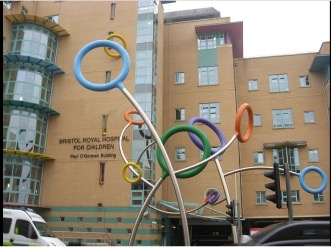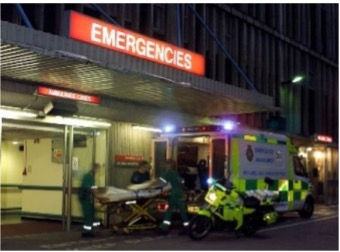Bristol Royal Hospital for Children (BRHC) Improves Patient Safety through Digital Transformation, Removing Paper and Halving Triage Time.
Pioneering use of System C’s CareFlow Clinical Noting function has enabled BRHC’s busy paediatric Emergency Department (ED) to reduce reliance on paper forms. These electronic processes have halved the time it takes to triage patients, ensuring care is directed rapidly at the sickest children. In a further boost to patient care and safety, the rollout of a new digital Casualty card (Cas card) is transforming documentation and communication around the hospital – with significant efficiency and time-saving benefits.
Located in the city centre, Bristol Royal Hospital for Children is the only paediatric major trauma centre in South West England. The hospital, which is part of the University Hospitals Bristol and Weston NHS Foundation Trust (UHBW), provides a wide range of specialist paediatric surgery and consultancy services, including burns, oncology and cardiology, along with 10 wards, an intensive care unit and a Paediatric Emergency Department (ED).
Developing digital capability is central to the hospital’s mission to transform the efficiency and quality of patient services, and enhance health outcomes. The value of digital and electronic systems has been particularly significant in the busy Paediatric ED, an entry point to the hospital where patients are treated and, if necessary, referred to other areas of the hospital for examinations, tests, X-rays, operations, or admission to wards.
The Issues
In the challenging ED environment, where demand has been increasing year on year, time pressures on stretched resources can impact on patient safety. This is especially significant during periods of high demand such as the winter season, when respiratory and other potentially dangerous illnesses become prevalent. For example, in winter 2022, with a Group A Strep (Scarlet Fever) outbreak alongside peaks in COVID-19, RSV, and influenza, the Paediatric ED saw the average numbers of patients in the waiting room rise consistently and surge by up to 300% at times. Without digital clinical noting and improvements in triage processes, patient care would undoubtedly have been compromised.
Winter 2022 saw a trebling of families in the Children’s Emergency Department, from 35 to 100.
Infections and events such as chronic asthma attacks can quickly escalate in children, so triaging patients and alerting a clinician as quickly as possible is essential – but the danger signs can easily go undetected in a hectic ED environment, especially when the waiting room is full and the triage process is reliant on time-intensive form filling and a slow process, creating risk to the most critically ill children.
Putting digital notes at the heart of the triage process has had a significant impact on how quickly we identify and treat patients who need immediate intervention. This innovation is a big improvement on previous practices, allowing us to triage patients much more quickly and flag and treat those most at risk. As well as enhancing patient care and improving satisfaction with our service, this extra efficiency has undoubtedly helped to save lives.
Mark Lyttle, Consultant and Senior Research Fellow in Children’s Emergency Care at UHBW.
Directing Care to Those Most in Need
Every child who attends the ED is first triaged and assessed by a nurse, so that those with the highest clinical needs are identified and attended to first. The Bristol Paediatric ED team were aware that their hybrid paper and electronic processes of recording clinical information were not picking up urgent cases quickly enough. Paper forms must be passed on and read, and in worst case scenarios, such as sepsis or chronic asthma attacks, any time lost can result in a patient deteriorating while waiting to be triaged.
To alleviate this risk, it’s vital that the point of first contact – the triage – is fast and streamlined to eliminate potentially life-threatening delays. Working closely with the hospital’s Digital Services team, the Paediatric ED clinical team recognised that a digital solution was the most effective – and sustainable – way of speeding up triage times. Already using CareFlow EPR as part of ongoing digitisation, they identified that the interplay between EPR and manual processes were a factor in delays – and that better utilisation of CareFlow Clinical Noting functionality could transform triage and patient flow processes.
Phase 1 – the Triage Solution
Having previously used an electronic proforma, or paper, the team developed the Triage Details screen to be specific to their patients, incorporating the Manchester Triage System – the score-based clinical risk management tool used in EDs to ensure that patients are seen in order of clinical priority, rather than order of attendance.
The nurses now follow prompts on an electronic form, entering data and key observations of the patient’s condition that will automatically trigger any potential alerts (e.g. a high temperature or breathlessness). This process, coupled with the introduction of CareFlow Vitals, minimises free text data collection and removes the movement of paper around the ED. This saves time and improves the quality of data captured during triage.
Moving to digital systems has improved and enhanced the care nurses deliver. They are now able to access patient notes in real time, undertaking patient care and document care delivery immediately, rather than the previous system of hunting for notes and being interrupted whilst searching, and clinical care being delayed.
The implementation of Careflow Vitals and the digital Cas card at the same time made this a success and we undertook a significant amount of education with the nursing team to share the benefits of moving to digital systems, both to patient care and nursing workload. The ability to reduce the time patients are waiting for triage with a streamlined system has had a positive impact on patient safety which is felt across the nursing team.
As a senior team we work hard to embed new practice and it should not be underestimated that the positive approach from the senior team and sharing of good practice is pivotal in the success of teams embracing change, adapting to new systems and essentially providing safer, higher quality and patient focused care in a department that has surges in demand and is busier than we have previously known.
Lucinda Morse, CED Digital Programme Nursing Lead
A Potentially Life-Saving Digital Innovation
Using digital systems means vital information can now be captured and displayed in real time, so critical data regarding the patient’s condition can be seen and acted on without delay. Screen alerts immediately flag up areas of concern, such as sepsis risk, notifying the medical team that a particular patient needs emergency attention. The successful rollout has more than halved triage times, saving over 10 minutes per patient. Further improvements are planned to bring triage to less than 4 minutes per patient.
Phase 2 – Creating a Patient Digital Trail
Following the introduction of electronic triage, and service orders to replace paper-based outpatient referrals, tangible benefits drove the development and implantation of the digital Cas card clinical note. This facilitated extension of noting capability to all ED clinical documentation and was developed collaboratively between digital services and senior clinicians across the multi-professional team.
Capturing essential information electronically at each key state of the patient journey means that instead of transferring paper forms by hand, the Cas card electronically ‘follows’ the patient throughout the ED and observation unit. Separating the process of documentation from delivery of patient care has enabled more rapid intervention for emergency conditions, including administration of inhalers to children having asthma attacks.
Data is updated in real time on the patient’s digital Cas card to create an end-to-end electronic pathway, enabling visibility of critical clinical information, and tracking and management of all interactions across the different care settings – for example, ED to acute inpatient, theatres, X-Ray or ICU.
The next stage of development in digital clinical noting for UHBW is implementation of identical processes across the outpatient setting. Information from each environment drives and dynamically changes the information surfaced in new clinical notes depending on what is needed for each patient. This creates a real time single source of truth for clinical care for every patient.
With information now being captured in a digital format, the data can be reviewed and scrutinised, and known problems can be quantified. Any potential issues can be dealt with proactively and complications better understood, with appropriate actions or resources assigned to alleviate them.
This also enables more streamlined workflows, reducing the need for duplicative data entry where up-to-date information already exists, and reduces the potential for error – for example, documenting a patient’s medication history becomes a ‘check and edit’ process, rather than starting de novo at each attendance.
Other improvements to patient care that have been unlocked by use of a digital Cas card have included the use of coded prompts for care, and easy access to clinical guidance through the use of embedded hyperlinks, especially important in an environment through which clinical staff frequently rotate.
Coupled with the use of other products including CareFlow Workspace and CareFlow Connect, visibility of all essential patient information, and communication between professionals, has become much more effective and efficient in content, quality and time.
Implementing these processes has contributed significantly to the management of risk in the ED, and during the busiest days of winter 2022 enabled the clinical staff to rapidly operationalise a ‘satellite’ ED in the Outpatient Department using trolley-based hardware.
To date the digital Cas card has been used over 20,000 times and has received numerous instances of positive feedback. This is reflective of the engagement of the clinical team in adopting these digital processes into core working practices. It has been widely commented that although the introduction of novel digital processes has occurred rapidly, it has reflected a natural progression in working behaviour, and has contributed to improved governance, and faster turnaround, for patients.
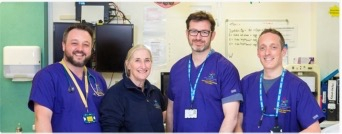
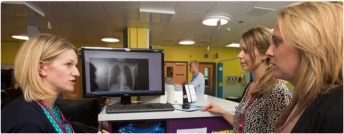
The rollout of our digital Cas card in our Paediatric ED has demonstrated that digital care pathways have clear advantages over traditional paper-based systems. In ED you don’t always see things coming, but this improvement has helped to make us ready for the future and enabled us to successfully manage unexpected volume peaks. Since its introduction, it has already delivered huge benefits in terms of patient flow, data reporting, push-pull data streams, decision making and providing trigger warnings.
It’s a very efficient way of ensuring that up-to-date information is captured and made available in real time on the EPR system, wherever and whenever a clinician needs to see it. In terms of efficiency, time saving, convenience and patient safety, it’s been a game changer. We’ll be building on this initiative in the next phase of our digitisation plan to create a more holistic view of the whole patient journey and transform the way people access our healthcare services.
Max Ward, Head of Clinical Systems at UHBW
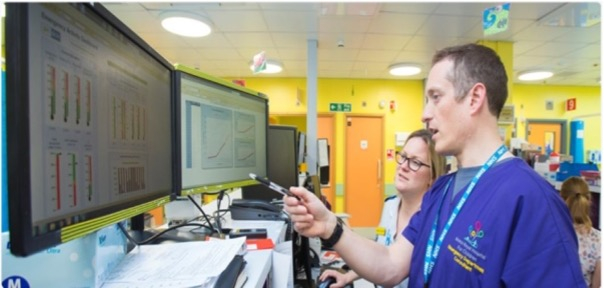
Benefits data - evidence of success
Halving Triage Time
Clinically it has been estimated that nursing time to triage has been reduced by 50% which in turn results in 50% more nursing time being freed up at the point of triage, equating to 600 nursing shifts per year. This improves patient safety and experience, reducing risk and improving the visibility of deteriorating patients.
Printing Cas Card Saving
By reducing the number of pages used per attendance and printing 50% fewer labels, printing costs per attendance have been reduced by 21p per attendance. This equates to a saving of £6620 since go live in July. There’s an estimated annual saving of £10.5k a year from printing costs alone.
Photocopying Saving
No longer photocopying on Admission has resulted in a saving of 31603 pages and 360 hours of nursing time since go live on 26/07/22. Annually, the expected saving is 48840 pages and 555 hours of nursing time.

This collaborative project has showcased the benefits of working in an agile way, with equal participation from Clinicians and Digital Services. We have a regular forum for Clinicians to raise the main problems facing the Department, and from there we can explore the solutions available to us. By empowering Clinicians to dictate the road map, design and test the solutions then feedback on the outcome, we've been able to maintain engagement and impart innovative change quickly and successfully.
We also worked with the CED Reception team to analyse and improve the patient registration process. By identifying quick wins in CareFlow EPR, e.g. reordering mandatory drop-down lists and auto selecting documents to be printed, we have been able to speed up the time it takes for patients to be seen. These improvements have now been mirrored in other ED Receptions, and we'll continue to look at system optimisation throughout the patient journey.
Jenni Leewarden, Business Analysis Team Manager
The range of realised digital benefits
- Improved clinical safety and better outcomes for patients – the number one benefit.
- More efficient workflows – less time-consuming paperwork so staff can focus on patient care and other duties.
- Quicker identification of acute needs – by cutting triage times in half, the department can free up nursing time to deliver care.
- Clinical efficiency – less chance of paper going astray, less handwriting errors and less duplication.
- Faster throughput – so fewer queues, shorter waiting times and higher patient satisfaction.
- Nurses no longer need to photocopy notes when a patient is admitted. This equates to ~555 nursing hours a year saved.
- ED needs fewer triage nurses on duty at the same time – so savings on staff resourcing.
- 66% reduction in scanning by reducing the number of pages used per attendance. This equates to around 220 hours of time saved for Receptionists each year.
- Reduction in triage times alone will save over 600 nursing shifts per year.
- Monitoring patients – electronic triggers notifying staff of care needs keep patients safer, especially during surge activity periods.
- Accountability for every action allows clear tracking of lines of communication.
- Paper-saving benefits, supporting the Trust’s commitment to sustainability and net zero – since the new triage system was introduced, the Trust estimates it is saving over 400K sheets of paper a year through having a smaller paper booklet and not having to photocopy paper Cas cards. Once electronic prescribing has been rolled out, they should be able to eliminate almost all paper used in the Department.
- Cost savings – based on recent attendances, the Trust estimates it will save at least £10.5K a year on Cas card printing and label costs.
- Fewer lengthy admin tasks – for example, discharge letters to a GP can now be sent using proforma letter templates.
- Space savings – less need for printers, photocopiers, and storage space for bulky paper records.
- Digitising outpatient referrals means clinic-coordinators have instant access to new referrals, cutting the waiting time for triage and subsequent appointments. This also means 1 piece of paper saved per OP referral – over 4K since go live.
- Unlocking other digital systems – including note dictation, and pre-formatted text import.
- Unlocking other non-digital processes – modifying human behaviour to be less dependent on a single source of paper notes, enabling multiple workflows for a given patient to be delivered safely simultaneously.
- Improved governance – with every action tracked, any delays or miscommunication can be rapidly identified and corrected.
- Reputational benefits for the Trust – a powerful demonstration of how innovative thinking translates into better quality patient care.
Summary from the Digital Children’s ED Team
The culmination of several years’ work, over a few months we implemented a number of new digital solutions and processes. This has reduced administrative and associated clinical burden, given us more time to care, and increased patient safety and quality of care.
Now we have laid the foundations of digitising the department, the next phase is about capitalising on the opportunities we’ve unlocked. We’ll further refine and disrupt processes and combine with other available functionality to deliver faster, slicker patient care.
The impending introduction of CareFlow Medicines Management and Clinical Narrative, will allow us to achieve becoming a paperless ED and move us significantly further forwards towards our ambition of becoming a truly Digital ED. Furthermore, the data we capture digitally will drive further improvements that can be replicated throughout the Trust.
This exciting development highlights what can be achieved when System C and its Trust customer work constructively together to turn a digital vision into a practical reality. Our collaboration with UHBW shows how System C software can be used and configured to best support patients and clinicians across a wide range of care settings, transforming efficient workflow and making a significant difference to the quality of care delivered by hospital teams within the communities they serve.
Dr Jon Shaw, System C’s Director of Clinical Services.
Learning from the Digital CED project and ongoing Outpatient noting projects has helped inform the Trust’s overall journey towards a fully digital patient record.





